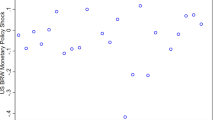Abstract
Gross stocks of foreign assets have increased rapidly relative to national outputs since 1990, and the short-run capital gains and losses on those assets can amount to significant fractions of GDP. These fluctuations in asset values render the national income and product account measure of the current account balance increasingly inadequate as a summary of the change in a country's net foreign assets. Nonetheless, unusually large current account imbalances, especially deficits, should remain high on policymakers' list of concerns, even, for the richer and less credit-constrained countries. Extreme imbalances signal the need for large and perhaps abrupt real exchange rate changes in the future, changes that might have undesired political and financial consequences given the incompleteness of domestic and international asset markets. Furthermore, of the two sources of the change in net foreign assets—the current account and the capital gain on the net foreign asset position—the former is better understood and more amenable to policy influence. Systematic government attempts to manipulate international asset values in order to change the net foreign asset position could have a destabilizing effect on market expectations. JEL no. F21, F32, F36, F41
Similar content being viewed by others
References
Adler, F. M., and B. Dumas (1983). International Portfolio Choice and Corporate Finance: A Survey.Journal of Finance 38 (3): 925–984.
Bekaert, G., C. R. Harvey, and C. Lundblad (2003). Growth Volatility and Financial Liberalization. NBER Working Paper 10560. National Bureau of Economic Research, Cambridge, Mass.
Branson, W. H., and D. W. Henderson (1985). The Specification and Influence of Asset Markets. In R. W. Jones and P. B. Kenen (eds.),Handbook of International Economics. Vol. 2, Amsterdam: North-Holland.
Calvo, G. A., and C. M. Reinhart (2002). Fear of Floating.Quarterly Journal of Economics 117 (2): 379–408.
Dornbusch, R. (2002). A Primer on Emerging-Market Crises. In S. Edwards and J. A. Frankel (eds.),Preventing Currency Crises in Emerging Markets. Chicago: University of Chicago Press.
Edwards, S. (2004). Thirty Years of Current Account Imbalances, Current Account Reversals, and Sudden Stops.IMF Staff Papers 51 (Special Issue): 1–49.
Eichengreen, B., and R. Hausmann (1999). Exchange Rates and Financial Fragility. In:New Challenges for Monetary Policy. Kansas City, Mo.: Federal Reserve Bank of Kansas City.
Gourinchas, P.-O., and H. Rey (2004). International Financial Adjustment. Photocopy. Berkeley and Princeton.
Grubel, H. G., and P. J. Lloyd (1975).Intra-Industry Trade: The Theory and Measurement of International Trade in Differential Products. London: Macmillan.
Husain, A., A. Mody, and K. Rogoff (2004), Exchange Rate Regime Durability and Performance in Developing Countries versus Advanced Economies. NBER Working Paper 10673. National Bureau of Economic Research, Cambridge, Mass.
Kouri, P. J. K., and J. B. de Macedo (1978). Exchange Rates and the International Adjustment Process.Brookings Papers on Economic Activity (1): 111–150.
Krugman, P. R. (1981). Consumption Preferences, Asset Demands, and Distribution Effects in International Financial Markets. NBER Working Paper 651. National Bureau of Economic Research, Cambridge, Mass.
Lane, P. R. (2001). Do International Investment Income Flows Smooth Income?Review of World Economics/Weltwirtschaftliches Archiv 137 (4): 714–736.
Lane, P. R., and G. M. Milesi-Ferretti (2001). The External Wealth of Nations: Measures of Foreign Assets and Liabilities for Industrial and Developing Countries.Journal of International Economics 55 (2): 263–294.
Lane, P. R., and G. M. Milesi-Ferretti (2004). Financial Globalization and Exchange Rates. Photocopy. Trinity College, Dublin, and IMF Washington.
Martin, P., and H. Rey (2001). Financial Super-Markets: Size Matters for Asset Trade. NBER Working Paper 8476. National Bureau of Economic Research, Cambridge, Mass.
Nocke, V., and S. Yeaple (2004). An Assignment Theory of Foreign Direct Investiment. Photocopy. University of Pennsylvania.
Obstfeld, M. (1986). Capital Mobility in the World Economy: Theory and Measurement.Carnegie-Rochester Conference Series in Public Policy 24 (Spring): 55–104.
Obstfeld, M. (2004). Globalization, Macroeconomic Performance, and the Exchange Rates of Emerging Economies.Monetary and Economic Studies (Bank of Japan) 22 (special issue): 29–55.
Obstfeld, M., and K. Rogoff (1996).Foundations of International Macroeconomics. Cambridge, Mass.: MIT Press.
Obstfeld, M., and K. Rogoff (2000). The Six Major Puzzles in International Macroeconomics: Is There a Common Cause?NBER Macroeconomics Annual 15: 339–390.
Obstfeld, M., and K. Rogoff (2004). The Unsustainable U.S. Current Account Position Revisited. NBER Working Paper, 10864, National Bureau of Economic Research, Cambridge, Mass.
Obstfeld, M., and A. M. Taylor (2004).Global Capital Markets: Integration, Crisis, and Growth. Cambridge: Cambridge University Press.
Reinhart, C. M., K. S. Rogoff, and M. Savastano (2003). Debt Intolerance.Brookings Papers on Economic Activity (1): 1–74.
Stockman, A. C. (1988). Fiscal Policies and International Financial Markets. In J. A. Frenkel (ed.),International Aspects of Fiscal Policies. Chicago: University of Chicago Press.
Stockman, A. C., and L. E. O. Svensson (1987). Capital Flows, Investment, and Exchange Rates.Journal of Monetary Economics 19 (2): 171–201.
Svensson, L. E. O. (1988). Trade in Risky Assets.American Economic Review 78 (8): 375–394.
Taylor, A. M. (2002). A Century of Current Account Dynamics.Journal of International Money and Finance 21 (6): 725–748.
Tille, C. (2003). The Impact of Exchange Rate Movements on U.S. Foreign Debt.Current Issues in Economics and Finance (Federal Reserve Bank of New York) 9 (1): 1–7.
Tille, C. (2004). Financial Integration and the Wealth Effect of Exchange Rate Fluctuations. Photocopy. Federal Reserve Bank of New York, New York.
Tobin, J. (1969). A General Equilibrium Approach to Monetary Theory.Journal of Money, Credit and Banking 1 (1): 15–29.
Ventura, J. (2002). Bubbles and Capital Flows. NBER Working Paper 9304. National Bureau of Economic Research. Cambridge, Mass.
Author information
Authors and Affiliations
Corresponding author
About this article
Cite this article
Obstfeld, M. External adjustment. Rev. World Econ. 140, 541–568 (2004). https://doi.org/10.1007/BF02659614
Issue Date:
DOI: https://doi.org/10.1007/BF02659614




